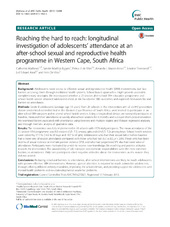| dc.description.abstract | Background: Adolescents need access to effective sexual and reproductive health (SRH) interventions, but face barriers accessing them through traditional health systems. School-based approaches might provide accessible, complementary strategies. We investigated whether a 21-session after-school SRH education programme and school health service attracted adolescents most at risk for adverse SRH outcomes and explored motivators for and barriers to attendance. Methods: Grade 8 adolescents (average age 13 years) from 20 schools in the intervention arm of an HIV prevention cluster randomised controlled trial in the Western Cape Province of South Africa, were invited to participate in an after-school SRH program and to attend school health services. Using a longitudinal design, we surveyed participants at baseline, measured their attendance at weekly after-school sessions for 6 months and surveyed them post-intervention. We examined factors associated with attendance using bivariate and multiple logistic and Poisson regression analyses, and through thematic analysis of qualitative data. Results: The intervention was fully implemented in 18 schools with 1576 trial participants. The mean attendance of the 21-session SRH programme was 8.8 sessions (S.D. 7.5) among girls and 6.9 (S.D. 7.2) among boys. School health services were visited by 17.3 % (14.9 % of boys and 18.7 % of girls). Adolescents who had their sexual debut before baseline had a lower rate of session attendance compared with those who had not (6.3 vs 8.5, p < .001). Those who had been victims of sexual violence or intimate partner violence (IPV), and who had perpetrated IPV also had lower rates of attendance. Participants were motivated by a wish to receive new knowledge, life coaching and positive attitudes towards the intervention. The unavailability of safe transport and domestic responsibilities were the most common barriers to attendance. Only two participants cited negative attitudes about the intervention as the reason they did not attend. Conclusions: Reducing structural barriers to attendance, after-school interventions are likely to reach adolescents with proven-effective SRH interventions. However, special attention is required to reach vulnerable adolescents, through offering different delivery modalities, improving the school climate, and providing support for adolescents with mental health problems and neurodevelopmental academic problems. | en_US |

